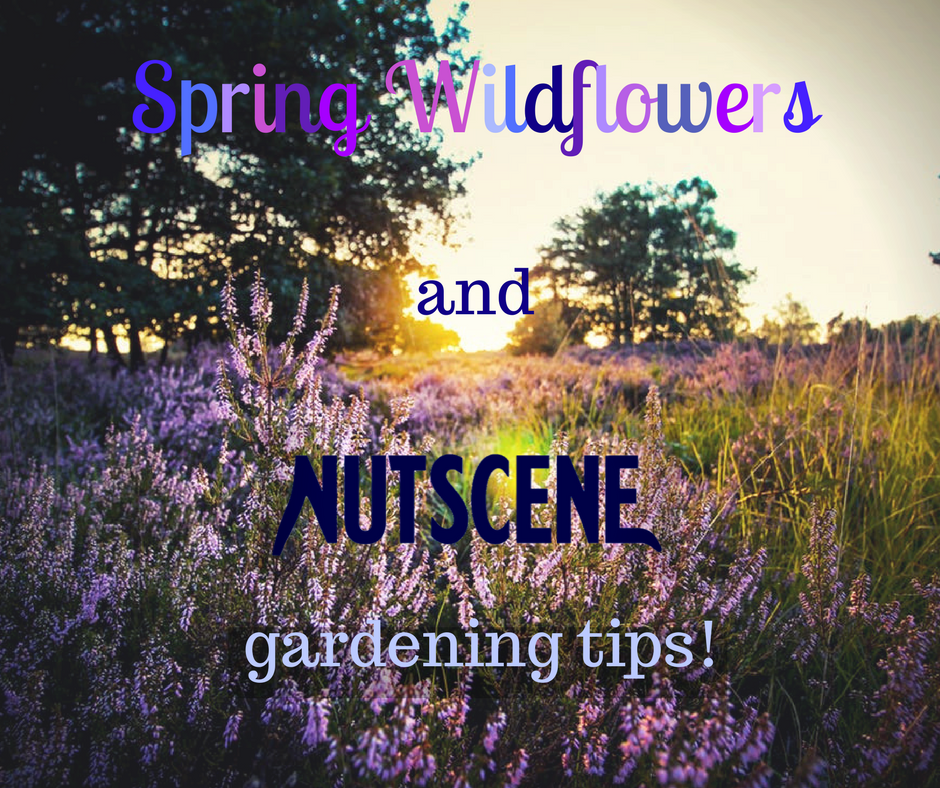
Spring Wildflowers and Nutscene's gardening tips!
Apr 13 , 2018

Spring is here! And there is nothing nicer than seeing the regrowth of greenery and the flowers starting to bud.

This week, Nutscene are looking into Britain's favourite wildflowers. We are also including some tips and tools so you can get the best out of your gardens over the spring period (you can thank us later!)
1. Ramsons (Allium ursinum)

Ramsons (also known as wild garlic) are often seen acting like a beautiful white carpet across many forest floors throughout the UK in Spring. Often you can smell the Ramsons' perfume before you see them!

This plant prefers woodland and can often be found in the damper areas. Flowering usually takes place between April and June.
Little tip: If you are going to cook with Ramsons, it is best to do so when the plant is young.
Now that Spring is here, the real preparation needs to be made to ensure that your garden is fully ready for the delights of the warmer months.

We recommend our Linen and Leather Gardeners Apron to ensure that you have all the right tools with you, when gardening season hits:
Heritage linen and Leather Gardeners Apron
Our handmade half length waist apron combines tough durable linen with our dark brown leather. Beautifully made in the UK, this quality apron is what every gardener is crying out for, allowing you to keep necessary tools and twine close whilst concentrating on the job in hand!

Just perfect for storing your tools (or phone) with a secure zipped pocket. Size can be adjusted with a webbing waist strap and buckle. It's a super gift for any gardener, muted colours means it's ideal for the man or woman in your life.
Click here for more information.
As Spring approaches, it is often a good idea to go around your flower beds and paths to clear the area. Pruning the old growth and refreshing the soil can really help your garden get into shape for Spring.
2. Primrose (Primula vulgaris)

This is another popular woodland flower that is admired during spring. This plant grows best in shaded spots and prefers moisture. This is one special plant, as it even has a day where it is celebrated across the UK - which is the 19th April in case you were wondering!

3. Wild Daffodil (Narcissus pseudonarcissus)


These plants also go by another name depending on where you are from - in England, they are often referred to as Lent Lillies. Daffodils are symbols for couples who are reaching their 10th year wedding anniversary.
It is a known tale that presenting 1 daffodil to someone is a gesture of bad luck - so remember, always have more than one at the ready!
As our favourite plants and flowers start to return to life again, sometimes these plants can get a mind of their own! Before you know it- they have grown arms and legs and are taking over their designated area.

We recommend our Gardeners Gift Set to help you keep your growing greenery in check!
Essentially Nutscene, Gardeners Gift set in Vintage Style Packaging

4. Bluebell (Hyacinthoides non-scripta)

These distinctively blue flowers are easily recognisable as a clear sign that Spring is here! Bluebells love shade and damp soil. If you keep your eyes peeled, you might spot a rare type of bluebells. This bluebell is white in colour because it lacks the blue pigment.

When you next have the joy of slowly strolling past Bluebells growing in abundance, think of this - around half of the world's Bluebell population grows in Britain. There is a Bluebell myth that says if you were a wreath of Bluebells around your neck that you cannot tell a lie.
Haws® Metal Indoor watering Cans

It is the time to really get prepared, and making sure you had a good quality watering system in place is important. Many new flowers need lots of hydration. Also if you are intending on tackling some bald spots within your grass by planting some grass seed - remember that this will need substantial watering to help the seeds bed in!
5. Wood Sorrel (Oxalis acetosella)
Wood Sorrel are recognised by their small white flowers. These plants enjoy woodland ground in shaded moist spots. These flowers can be identified by its three heart-shaped leaves. 
The Sorrel stems and leaves tend to have a tangy or sour lemon flavour. This plant is rich in Vitamin C and Vitamin A. Sorrel can be used to help a range of health issues such as a sore throat. Sorrel blooms during the spring and summer months. These flowers attract bees, butterflies and flies.

As your flowers and plants really start to thrive, remember not to forget about them. They still need your love! It might be watering, dead-heading or just checking as to whether the insects have been attacking them - but don't leave them to their own devices!
We hope you enjoyed this blog and some of our tips. Do you have a favourite wildflower that we didn't mention here? Let us know!
Lots of Love,
The Nutscene Team

